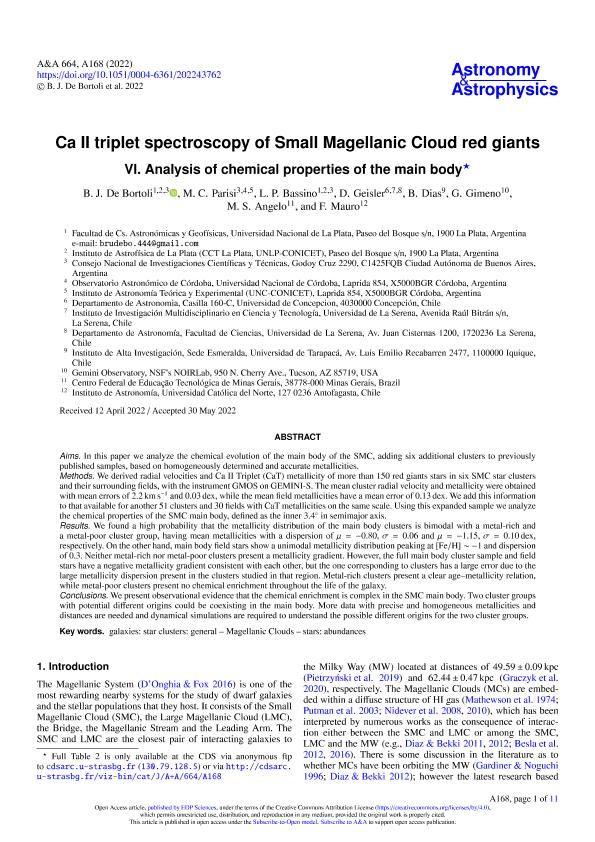Mostrar el registro sencillo del ítem
dc.contributor.author
de Bórtoli, Bruno Javier

dc.contributor.author
Parisi, Maria Celeste

dc.contributor.author
Bassino, Lilia Patricia

dc.contributor.author
Geisler, Doug

dc.contributor.author
Dias, Bruno

dc.contributor.author
Gimeno, G.
dc.contributor.author
Dangelo Farto, Marcela Silvina

dc.contributor.author
Mauro, F.
dc.date.available
2023-09-07T12:42:28Z
dc.date.issued
2022-08
dc.identifier.citation
de Bórtoli, Bruno Javier; Parisi, Maria Celeste; Bassino, Lilia Patricia; Geisler, Doug; Dias, Bruno; et al.; Ca II triplet spectroscopy of Small Magellanic Cloud red giants VI: Analysis of chemical properties of the main body; EDP Sciences; Astronomy and Astrophysics; 664; 8-2022; 168-179
dc.identifier.issn
0004-6361
dc.identifier.uri
http://hdl.handle.net/11336/210811
dc.description.abstract
Aims. In this paper we analyze the chemical evolution of the main body of the SMC, adding six additional clusters to previously published samples, based on homogeneously determined and accurate metallicities. Methods. We derived radial velocities and Ca II Triplet (CaT) metallicity of more than 150 red giants stars in six SMC star clusters and their surrounding fields, with the instrument GMOS on GEMINI-S. The mean cluster radial velocity and metallicity were obtained with mean errors of 2.2 km s-1 and 0.03 dex, while the mean field metallicities have a mean error of 0.13 dex. We add this information to that available for another 51 clusters and 30 fields with CaT metallicities on the same scale. Using this expanded sample we analyze the chemical properties of the SMC main body, defined as the inner 3.4◦ in semimajor axis. Results. We found a high probability that the metallicity distribution of the main body clusters is bimodal with a metal-rich and a metal-poor cluster group, having mean metallicities with a dispersion of µ = -0.80, σ = 0.06 and µ = -1.15, σ = 0.10 dex, respectively. On the other hand, main body field stars show a unimodal metallicity distribution peaking at [Fe/H] ∼ -1 and dispersion of 0.3. Neither metal-rich nor metal-poor clusters present a metallicity gradient. However, the full main body cluster sample and field stars have a negative metallicity gradient consistent with each other, but the one corresponding to clusters has a large error due to the large metallicity dispersion present in the clusters studied in that region. Metal-rich clusters present a clear age–metallicity relation, while metal-poor clusters present no chemical enrichment throughout the life of the galaxy. Conclusions. We present observational evidence that the chemical enrichment is complex in the SMC main body. Two cluster groups with potential different origins could be coexisting in the main body. More data with precise and homogeneous metallicities and distances are needed and dynamical simulations are required to understand the possible different origins for the two cluster groups.
dc.format
application/pdf
dc.language.iso
eng
dc.publisher
EDP Sciences

dc.rights
info:eu-repo/semantics/openAccess
dc.rights.uri
https://creativecommons.org/licenses/by-nc-sa/2.5/ar/
dc.subject
GALAXIES: STAR CLUSTERS: GENERAL
dc.subject
MAGELLANIC CLOUDS
dc.subject
STARS: ABUNDANCES
dc.subject.classification
Astronomía

dc.subject.classification
Ciencias Físicas

dc.subject.classification
CIENCIAS NATURALES Y EXACTAS

dc.title
Ca II triplet spectroscopy of Small Magellanic Cloud red giants VI: Analysis of chemical properties of the main body
dc.type
info:eu-repo/semantics/article
dc.type
info:ar-repo/semantics/artículo
dc.type
info:eu-repo/semantics/publishedVersion
dc.date.updated
2023-09-05T18:02:21Z
dc.journal.volume
664
dc.journal.pagination
168-179
dc.journal.pais
Francia

dc.description.fil
Fil: de Bórtoli, Bruno Javier. Consejo Nacional de Investigaciones Científicas y Técnicas. Centro Científico Tecnológico Conicet - La Plata. Instituto de Astrofísica La Plata. Universidad Nacional de La Plata. Facultad de Ciencias Astronómicas y Geofísicas. Instituto de Astrofísica La Plata; Argentina
dc.description.fil
Fil: Parisi, Maria Celeste. Consejo Nacional de Investigaciones Científicas y Técnicas. Centro Científico Tecnológico Conicet - Córdoba. Instituto de Astronomía Teórica y Experimental. Universidad Nacional de Córdoba. Observatorio Astronómico de Córdoba. Instituto de Astronomía Teórica y Experimental; Argentina
dc.description.fil
Fil: Bassino, Lilia Patricia. Consejo Nacional de Investigaciones Científicas y Técnicas. Centro Científico Tecnológico Conicet - La Plata. Instituto de Astrofísica La Plata. Universidad Nacional de La Plata. Facultad de Ciencias Astronómicas y Geofísicas. Instituto de Astrofísica La Plata; Argentina
dc.description.fil
Fil: Geisler, Doug. Universidad de La Serena; Chile. Universidad de Concepción; Chile
dc.description.fil
Fil: Dias, Bruno. Universidad de Tarapacá; Chile
dc.description.fil
Fil: Gimeno, G.. No especifíca;
dc.description.fil
Fil: Dangelo Farto, Marcela Silvina. No especifíca;
dc.description.fil
Fil: Mauro, F.. Universidad Católica del Norte; Chile
dc.journal.title
Astronomy and Astrophysics

dc.relation.alternativeid
info:eu-repo/semantics/altIdentifier/doi/http://dx.doi.org/10.1051/0004-6361/202243762
Archivos asociados
